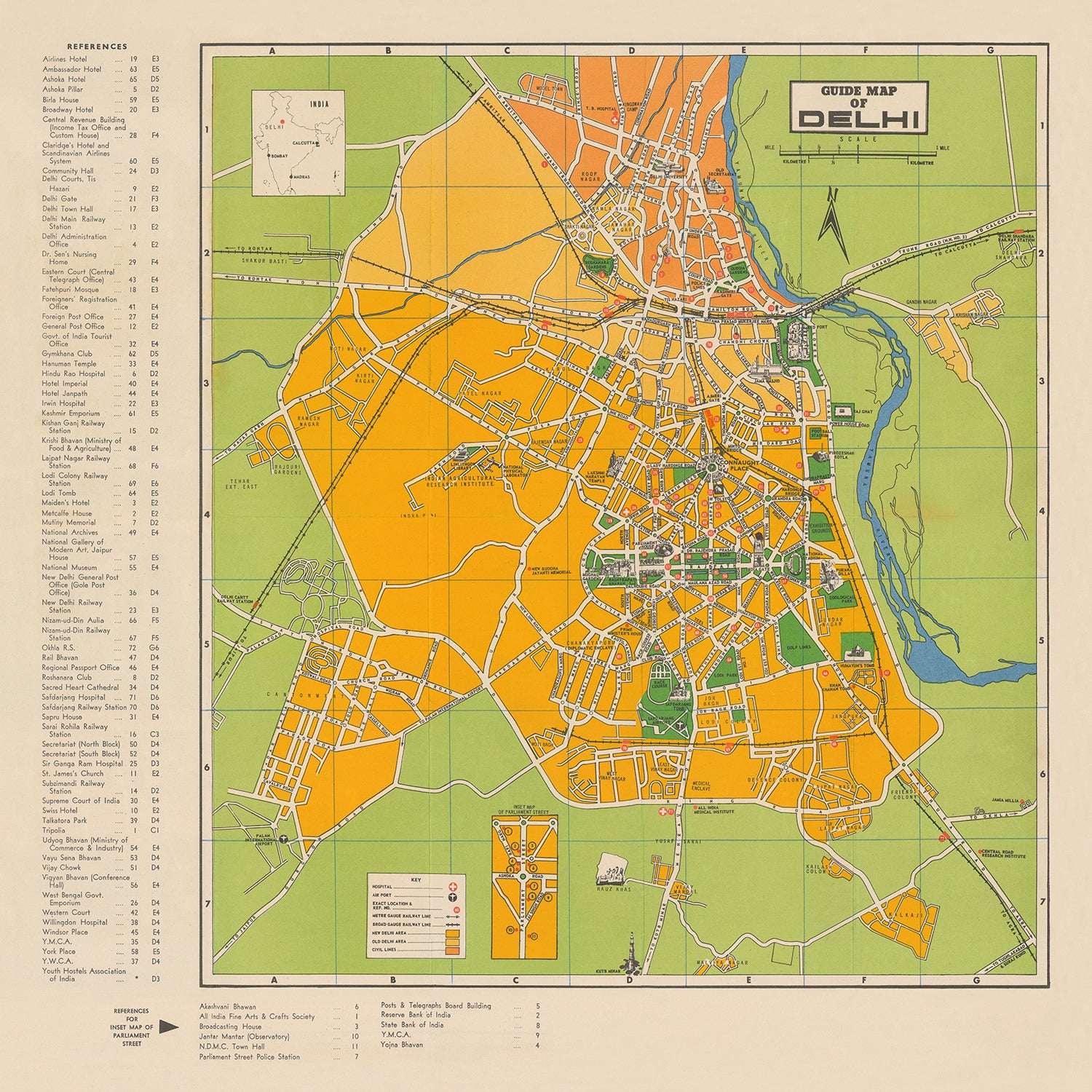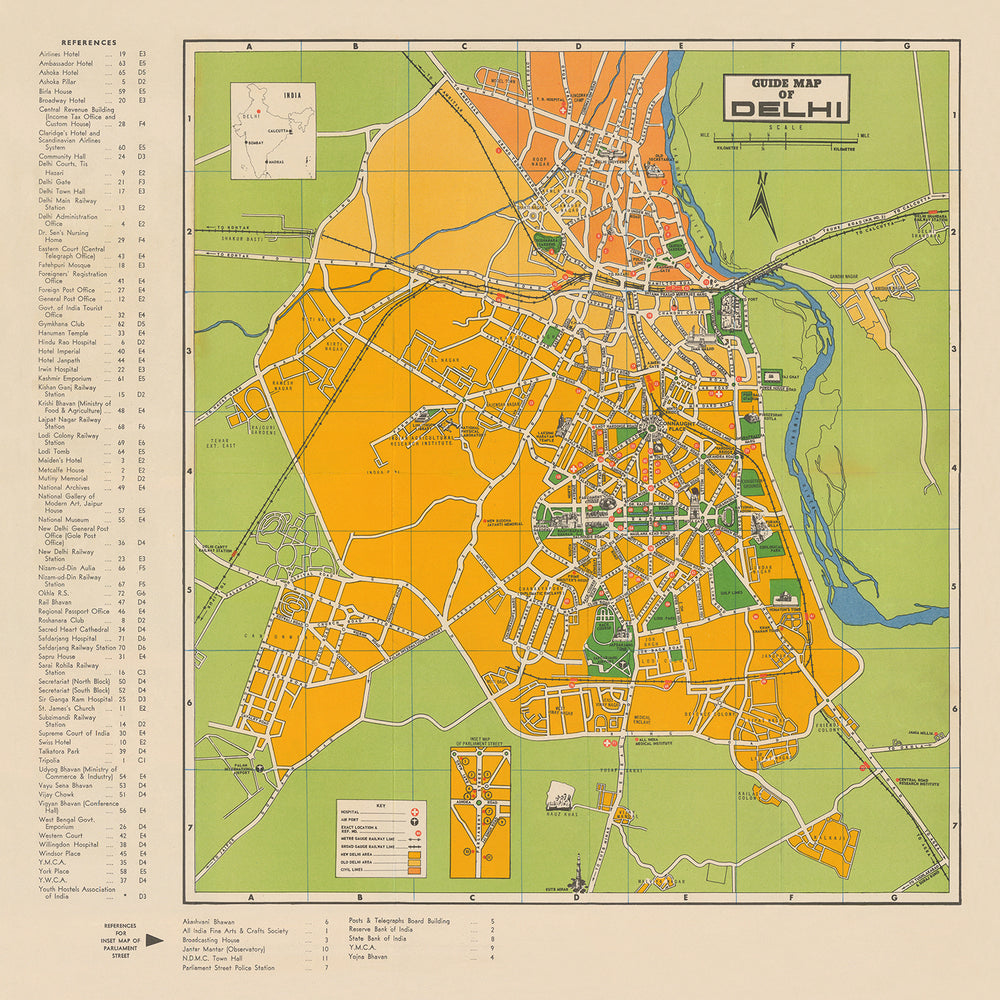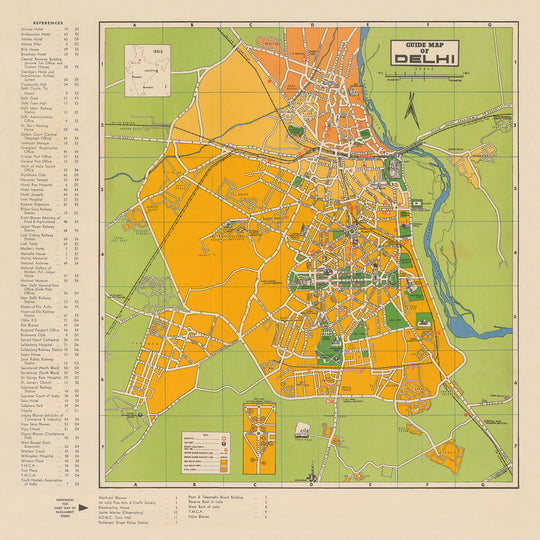- Handmade locally. No import duty or tax
- FREE Delivery by Christmas
- Love it or your money back (90 days)
- Questions? WhatsApp me any time
Own a piece of history
5,000+ 5 star reviews


The "Guide Map of Delhi," created by the Government of India in 1961, is a vibrant and meticulously detailed representation of one of the world's most historically rich cities. This map captures the essence of Delhi during a transformative period, providing a comprehensive layout of its streets, significant buildings, and points of interest. Each road and landmark is clearly labeled, offering a vivid snapshot of the city's urban landscape over six decades ago. The map’s bright colors and precise detailing reflect the careful planning and significant efforts of the mapmakers, making it an invaluable resource for historians and enthusiasts alike.
Delhi, a city steeped in history and culture, is brought to life through this map's depiction of its iconic neighborhoods and landmarks. From the bustling Chandni Chowk to the vibrant Karol Bagh and the historically significant Paharganj, each area is intricately mapped out, showcasing the diverse and dynamic character of the city. The map also highlights key landmarks such as the majestic Red Fort, the towering Qutab Minar, and the solemn Humayun's Tomb, each a testament to Delhi's rich architectural heritage and historical significance.
The map also provides a detailed view of Delhi's extensive road network, with major thoroughfares like Rajpath, Janpath, and Connaught Place prominently featured. These roads not only facilitate navigation but also tell the story of Delhi's urban development and planning. The inclusion of significant buildings such as the Parliament House and Rashtrapati Bhavan underscores the city's role as the political heart of India. The meticulous labeling of streets and roads offers a fascinating glimpse into the city's infrastructure and the careful planning that has shaped its growth.
Natural features such as the Purana Qila Lake and the lush expanse of Lodhi Gardens are also prominently displayed, offering a glimpse into the green spaces that provide respite from the city's bustling streets. The map's depiction of these parks and lakes highlights the importance of nature within the urban environment, reflecting a balance between development and preservation. These features not only enhance the city's aesthetic appeal but also serve as historical and cultural landmarks in their own right.
The historical significance of this map extends beyond its detailed cartography; it serves as a window into Delhi's past, capturing the essence of a city in the midst of change. The Government of India's dedication to producing such a detailed and accurate map underscores the importance of documenting and preserving the urban landscape for future generations. This map is not just a tool for navigation but a piece of history, offering a unique perspective on Delhi's evolution and its enduring legacy as a cultural and political hub.
Streets and roads on this map
- Ajmeri Gate
- Alipur Road
- Asaf Ali Road
- Bahadur Shah Zafar Marg
- Barakhamba Road
- Bhagwan Das Road
- Bhai Vir Singh Marg
- Bypass Road
- Chelmsford Road
- Circular Road
- Connaught Circus
- Connaught Place
- Curzon Road
- Desh Bandhu Gupta Road
- Gokhale Market Road
- Hailey Road
- Hanuman Road
- Hardinge Avenue
- Janpath
- Kasturba Gandhi Marg
- Lodi Road
- Mathura Road
- Minto Road
- Parliament Street
- Patel Road
- Panchkuian Road
- Prithviraj Road
- Pusa Road
- Rajpath
- Ring Road
Notable Features & Landmarks
- Inset maps:
- Small inset map showing the location of Delhi within India.
- Landmarks:
- Red Fort
- Qutab Minar
- India Gate
- Parliament House
- Rashtrapati Bhavan (President's House)
- Humayun's Tomb
- Connaught Place
- Neighbourhoods:
- Chandni Chowk
- Karol Bagh
- Paharganj
- Lakes:
- Purana Qila Lake
- Large parks:
- Lodhi Gardens
Historical and design context
- Brightly colored map of Delhi, published by the Government of India.
- The map provides a layout of Delhi's streets, significant buildings, and other points of interest, which are identified numerically in the key at the left.
- All roads are labelled on the map.
- Date created: 1961
- Mapmaker or publisher: Government of India
- The Government of India has a long history of producing detailed and accurate maps for administrative and public use.
- This map serves both as a guide for navigation and as a historical record of Delhi’s urban development in the early 1960s.
- Countries and regions shown: Delhi, India
- Design or style:
- Bright colors for different areas
- Detailed street labelling
- Numerical key for significant buildings and points of interest
- Historical significance:
- This map provides a snapshot of Delhi’s urban landscape in 1961, reflecting its infrastructure and points of interest during that period.
- It is an important historical document for understanding the development and planning of Delhi.
Please double check the images to make sure that a specific town or place is shown on this map. You can also get in touch and ask us to check the map for you.
This map looks great at every size, but I always recommend going for a larger size if you have space. That way you can easily make out all of the details.
This map looks amazing at sizes all the way up to 70in (180cm). If you are looking for a larger map, please get in touch.
The model in the listing images is holding the 16x16in (40x40cm) version of this map.
The fifth listing image shows an example of my map personalisation service.
If you’re looking for something slightly different, check out my collection of the best old maps to see if something else catches your eye.
Please contact me to check if a certain location, landmark or feature is shown on this map.
This would make a wonderful birthday, Christmas, Father's Day, work leaving, anniversary or housewarming gift for someone from the areas covered by this map.
This map is available as a giclée print on acid free archival matte paper, or you can buy it framed. The frame is a nice, simple black frame that suits most aesthetics. Please get in touch if you'd like a different frame colour or material. My frames are glazed with super-clear museum-grade acrylic (perspex/acrylite), which is significantly less reflective than glass, safer, and will always arrive in perfect condition.
This map is also available as a float framed canvas, sometimes known as a shadow gap framed canvas or canvas floater. The map is printed on artist's cotton canvas and then stretched over a handmade box frame. We then "float" the canvas inside a wooden frame, which is available in a range of colours (black, dark brown, oak, antique gold and white). This is a wonderful way to present a map without glazing in front. See some examples of float framed canvas maps and explore the differences between my different finishes.
For something truly unique, this map is also available in "Unique 3D", our trademarked process that dramatically transforms the map so that it has a wonderful sense of depth. We combine the original map with detailed topography and elevation data, so that mountains and the terrain really "pop". For more info and examples of 3D maps, check my Unique 3D page.
For most orders, delivery time is about 3 working days. Personalised and customised products take longer, as I have to do the personalisation and send it to you for approval, which usually takes 1 or 2 days.
Please note that very large framed orders usually take longer to make and deliver.
If you need your order to arrive by a certain date, please contact me before you order so that we can find the best way of making sure you get your order in time.
I print and frame maps and artwork in 23 countries around the world. This means your order will be made locally, which cuts down on delivery time and ensures that it won't be damaged during delivery. You'll never pay customs or import duty, and we'll put less CO2 into the air.
All of my maps and art prints are well packaged and sent in a rugged tube if unframed, or surrounded by foam if framed.
I try to send out all orders within 1 or 2 days of receiving your order, though some products (like face masks, mugs and tote bags) can take longer to make.
If you select Express Delivery at checkout your order we will prioritise your order and send it out by 1-day courier (Fedex, DHL, UPS, Parcelforce).
Next Day delivery is also available in some countries (US, UK, Singapore, UAE) but please try to order early in the day so that we can get it sent out on time.
My standard frame is a gallery style black ash hardwood frame. It is simple and quite modern looking. My standard frame is around 20mm (0.8in) wide.
I use super-clear acrylic (perspex/acrylite) for the frame glass. It's lighter and safer than glass - and it looks better, as the reflectivity is lower.
Six standard frame colours are available for free (black, dark brown, dark grey, oak, white and antique gold). Custom framing and mounting/matting is available if you're looking for something else.
Most maps, art and illustrations are also available as a framed canvas. We use matte (not shiny) cotton canvas, stretch it over a sustainably sourced box wood frame, and then 'float' the piece within a wood frame. The end result is quite beautiful, and there's no glazing to get in the way.
All frames are provided "ready to hang", with either a string or brackets on the back. Very large frames will have heavy duty hanging plates and/or a mounting baton. If you have any questions, please get in touch.
See some examples of my framed maps and framed canvas maps.
Alternatively, I can also supply old maps and artwork on canvas, foam board, cotton rag and other materials.
If you want to frame your map or artwork yourself, please read my size guide first.
My maps are extremely high quality reproductions of original maps.
I source original, rare maps from libraries, auction houses and private collections around the world, restore them at my London workshop, and then use specialist giclée inks and printers to create beautiful maps that look even better than the original.
My maps are printed on acid-free archival matte (not glossy) paper that feels very high quality and almost like card. In technical terms the paper weight/thickness is 10mil/200gsm. It's perfect for framing.
I print with Epson ultrachrome giclée UV fade resistant pigment inks - some of the best inks you can find.
I can also make maps on canvas, cotton rag and other exotic materials.
Learn more about The Unique Maps Co.
Map personalisation
If you're looking for the perfect anniversary or housewarming gift, I can personalise your map to make it truly unique. For example, I can add a short message, or highlight an important location, or add your family's coat of arms.
The options are almost infinite. Please see my map personalisation page for some wonderful examples of what's possible.
To order a personalised map, select "personalise your map" before adding it to your basket.
Get in touch if you're looking for more complex customisations and personalisations.
Map ageing
I have been asked hundreds of times over the years by customers if they could buy a map that looks even older.
Well, now you can, by selecting Aged before you add a map to your basket.
All the product photos you see on this page show the map in its Original form. This is what the map looks like today.
If you select Aged, I will age your map by hand, using a special and unique process developed through years of studying old maps, talking to researchers to understand the chemistry of aging paper, and of course... lots of practice!
If you're unsure, stick to the Original colour of the map. If you want something a bit darker and older looking, go for Aged.
If you are not happy with your order for any reason, contact me and I'll get it fixed ASAP, free of charge. Please see my returns and refund policy for more information.
I am very confident you will like your restored map or art print. I have been doing this since 1984. I'm a 5-star Etsy seller. I have sold tens of thousands of maps and art prints and have over 5,000 real 5-star reviews. My work has been featured in interior design magazines, on the BBC, and on the walls of dozens of 5-star hotels.
I use a unique process to restore maps and artwork that is massively time consuming and labour intensive. Hunting down the original maps and illustrations can take months. I use state of the art and eye-wateringly expensive technology to scan and restore them. As a result, I guarantee my maps and art prints are a cut above the rest. I stand by my products and will always make sure you're 100% happy with what you receive.
Almost all of my maps and art prints look amazing at large sizes (200cm, 6.5ft+) and I can frame and deliver them to you as well, via special oversized courier. Contact me to discuss your specific needs.
Or try searching for something!















































